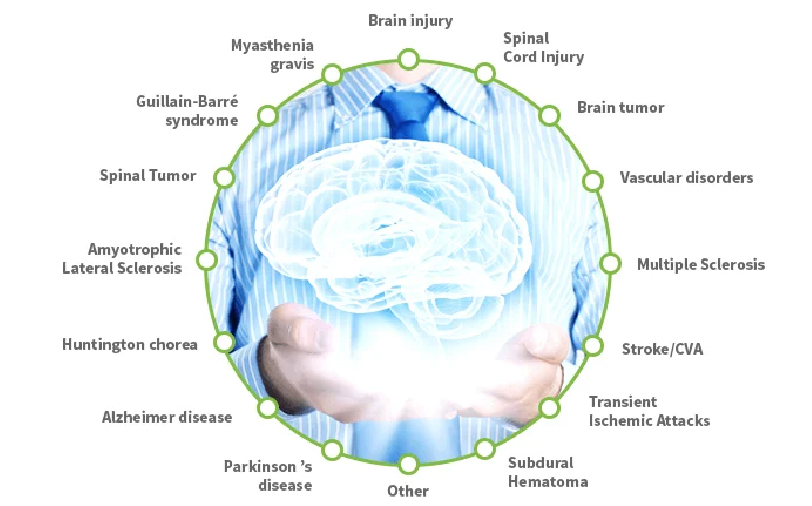Book an Appointment
Call Us+91 9319488481Brain injury is an acute condition that involves violent shaking or impact on the brain. The brain may bounce or move violently inside the skull due to the impact, causing parts of the brain to hit against the inner wall of the skull, which can result in bruising, bleeding, or other forms of injury to the brain tissue. Traumatic Brain Injury (TBI) can occur in various situations, such as during traffic accidents, falls, sports, or even violent acts. The degrees of TBI range from mild—sometimes referred to as a concussion, where, for example, a person may experience temporary confusion or headache—to severe, where a person may suffer from lifelong impairment, physical disability, or even death. Understanding the types of traumatic brain injury is crucial for planning treatment and assessing prognosis.
Neurorehabilitation is a specialized therapy aimed at helping people with TBI and other neurological conditions. It focuses on the maximum possible restoration of a patient's former abilities to perform activities and tasks that they used to handle with ease, thereby facilitating easier living. This coordinated approach involves neurologists, physiotherapists, occupational and speech therapists, and psychologists, among others, due to the wide range of symptoms related to TBI affecting physical, cognitive, psychological, and behavioral aspects.
Neurorehabilitation is individualized because no two cases of brain injury are identical. It typically starts with a thorough evaluation of the patient to identify the damaged areas of the brain and determine the appropriate treatment. Based on this assessment, the patient undergoes a customized rehabilitation program tailored to address their specific challenges.

Recent advancements in neurorehabilitation have leveraged the brain's ability to repair itself, a concept known as neuroplasticity. These approaches aim to help the brain generate new neural pathways and rewire itself following injury.
Constraint-Induced Therapy is a widely used technique designed to improve motor function in individuals with upper extremity impairments resulting from TBI. The method involves restraining the unaffected limb, compelling the patient to use only the affected limb for daily activities. This approach enhances the brain's ability to relearn motor skills by strengthening neural pathways associated with the impaired limb and promoting neuroplasticity. With intensive practice, significant improvements in motor function and coordination can be achieved over time.
Repetitive Task Training involves patients practicing specific tasks repeatedly to enhance motor function and cognitive skills. The repetition provides the brain with the necessary stimulation to form new neural pathways and reinforce existing ones, which is critical for recovery. RTT can be particularly effective in reacquiring daily living skills such as walking, dressing, and eating, thereby supporting independence.
Cognitive rehabilitation addresses the cognitive deficits that often follow TBI, including memory loss, difficulty with attention, problem-solving deficiencies, and executive functioning issues. Techniques in cognitive rehabilitation include memory aids like calendars and checklists, cognitive training exercises, and compensatory strategies that help individuals adapt to cognitive impairments. The goal is to enhance mental functions to improve concentration, planning, and decision-making.
Virtual Reality Therapy is an emerging neurorehabilitation field that uses immersive technology to create a safe and controlled environment where patients with TBI can practice functional skills. VRT can be effective for treating balance, coordination, and spatial perception disturbances, as well as emotional and psychological challenges such as anxiety and depression. The interactive nature of VRT allows for repeated practice and feedback, which are crucial for recovery.
Medications are sometimes integrated into neurorehabilitation programs to address specific TBI symptoms. Antidepressants may be used for depression, anxiolytics for anxiety, or anticonvulsants for seizure control. Pharmacological interventions typically complement other forms of treatment to enhance overall outcomes.
Neuroplasticity refers to the brain's capacity to adapt in response to injury or experience and learning. It can be loosely defined as the brain's ability to reorganize itself by compensating for damaged areas following TBI. This concept is fundamental to neurorehabilitation as it provides the basis for recovery. Neuroplasticity enables cognitive recovery, allowing patients to acquire new skills and regain lost abilities.
Activation of neuroplasticity is crucial in rehabilitation settings as it allows the brain to repair itself and restore functionality. The success of neurorehabilitation depends on the timing and dosage of treatments; therefore, early and frequent interventions are essential.
Traumatic brain injury is a complex condition that can affect various systems—physical, cognitive, and psychosocial. However, with appropriate neurorehabilitation strategies, there is significant potential for improvement. Modern techniques such as constraint-induced therapy, repetitive task training, cognitive rehabilitation, virtual reality therapy, and pharmacological interventions are fostering the development of new neuromuscular connections and enhancing patients independence and quality of life. If you or someone you know has experienced TBI, it is crucial to seek professional help from a neurorehabilitation specialist as early as possible to maximize the potential for recovery. Support and understanding, both
physically and emotionally, are key to realizing a successful recovery.
Q: Which factors most frequently cause traumatic brain injury?
A: The most common causes are auto accidents, which are followed by assaults, falls, and sports injuries.
Q: Can a minor traumatic brain injury result in chronic issues?
A: While many people with mild traumatic brain injury recover completely, some may experience persistent symptoms such as headaches, fatigue, or cognitive problems.
Q: Do traumatic brain injuries have a cure?
A: Although there is not a cure for traumatic brain injury (TBI), neuro rehabilitation can greatly enhance function and quality of life.
Q: What is the objective of neurorehabilitation for traumatic brain injury?
A: Neurorehabilitation aims to help patients regain lost skills, increase their level of independence, and improve their overall quality of life.
Q: Which therapeutic modalities are applied in neurorehabilitation?
A: Common approaches include physical therapy, occupational therapy, speech therapy, cognitive
rehabilitation, and virtual reality therapy.